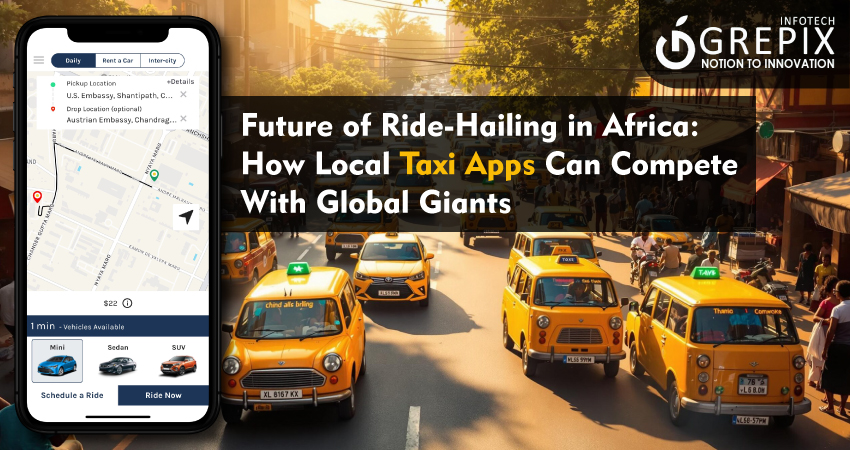Future of Ride-Hailing in Africa: How Local Taxi Apps Can Compete With Global Giants
Local ride-hailing apps across Africa are stepping up to meet the diverse needs of urban commuters, offering robust competition to global giants. Leveraging unique market gaps, affordability, offline payments, and driver partnerships, the future of taxi app Africa, Uber alternative Africa, and local ride-hailing app solutions looks promising..
Africa’s ride-hailing market is evolving, driven by rapid urbanization, increased smartphone adoption, and changing consumer needs. Local taxi app Africa platforms are closing affordability gaps, offering offline payment systems, and forging strong driver partnerships. By customizing for local languages, payment habits, and mobility types, these apps are outpacing global Uber alternative Africa services. This article explores market dynamics, real examples, and actionable insights for launching a successful local ride-hailing app in Africa.
1Africa Ride-Hailing Market Overview
Africa’s ride-hailing market is predicted to reach $3.39 billion by 2029, with user penetration rising to 18.5% and a projected user base of over 268 million. Urbanization, tourism, and tech adoption are fueling this growth. Markets like South Africa, Kenya, and Nigeria lead the charge, but region-specific needs mean local ride-hailing app solutions have a strong advantage
| Year | Market Value ($bn) | User Penetration (%) |
|---|---|---|
| 2025 | 2.53 | 14.8 |
| 2029 | 3.39 | 18.5 |
| 2030 | 3.16 | — |
2Why Market Gaps Create Opportunity for Local Taxi App Africa Platforms
Tailoring to Local Preferences
Global giants often overlook nuances like regional transport types (e.g., motorcycle taxis), local language support, and offline payment methods that are crucial in Africa’s fragmented market. By addressing these market gaps, local ride-hailing app Africa platforms deliver superior value:
- Mobile money payments and offline options for unbanked riders.
- Multilingual app interfaces supporting local dialects.
- Fare negotiation and flexible pricing, popular in apps like inDrive and Rida.
Case Study: SafeBoda & Gokada
SafeBoda (Uganda, Kenya, Nigeria) and Gokada (Nigeria) focus on motorbike taxis, real-time tracking, and affordable pricing to fit African urban landscapes, proving that local adaptation trumps global import models.
3Affordability: The Leading Competitive Edge
Pricing Models That Win
A significant 37% of users choose their ride-hailing app based on affordability. Peer-to-peer pricing models, transparent fares, and low commissions are commonly used:
- inDrive lets riders propose fares, with drivers free to negotiate.
- Bolt and Uber offer standard pricing but face stiff competition from local apps’ flexible models.
| App | Pricing Type | Affordability Score* |
|---|---|---|
| Bolt | Flat/Low commission | High |
| Uber | Flat pricing | High |
| inDrive | Peer-to-peer | Very High |
| Rida | Fare negotiation | Very High |
| SafeBoda / Gokada | Motorbike rides | High |
| *Affordability score is a comparative indicator (very high / high) — adjust wording as needed. | ||
Affordability scores based on user reports and payment flexibility.
Serving Unbanked Customers
With 62% market share, mobile money dominates African ride-hailing payments, supporting riders with cash flow realities and boosting accessibility.
4Offline Payments: Critical for Taxi App Africa Success
Innovative Payment Solutions
Local taxi app Africa platforms excel at offering cash, QR code, wallet, and mobile money options. SAPay and Welcome Africa enable secure payments through QR codes and mobile money integrations, even for riders without smartphones.
- SAPay: Works with minibus taxis, supports tap, scan, and wallet payments.
- Welcome Africa: Offers QR-based payments, Orange Money integration, and expense tracking for safe, instant transactions.
Bridging Digital Divides
Offline payment capability attracts vast populations excluded from digital banking and helps local taxi app Africa maintain high adoption even in remote towns.
Also Read: "How to Launch a Multi-Restaurant Food Delivery App in 2025"
5 Driver Partnerships: Key for Local Ride-Hailing App Growth
Building a Sustainable Driver Ecosystem
- Strong local ride-hailing app platforms invest in:
- Local driver recruitment ensuring cultural alignment and better service.
- Flexible bonus schemes, daily/weekly ride targets, and transparent earnings management.
- Safety protocols: driver background checks, rider feedback, emergency support.
Case Study: HerRyde & LEFA
HerRyde (Nigeria) only serves female riders with female drivers, addressing specific user needs and safety concerns. LEFA (Namibia) specializes in driver training and customer experience, offering extra services like city tours and airport transfers for tourists.
Impact
By localizing driver partnerships, local ride-hailing app Africa startups create greater loyalty, improve safety, and build trust faster than global competitors dependent on remote support structures.
6 How Local Ride-Hailing Apps Outcompete Uber Alternatives in Africa
Custom Payment Methods
Local taxi app Africa solutions dominate by supporting mobile money, cash, and cards. Apps like SafeBoda and SAPay have streamlined for Africa’s unique payment landscape.
Regional Vehicle Choices
Adaptation to regional transportation (minibus, boda boda) makes services far more practical and affordable.
Language & Community Features
Multilingual support and integration with community groups foster stronger engagement and higher retention.
Flexible Pricing and Peer-to-Peer Negotiation
Features like inDrive’s fare negotiation give riders and drivers direct control over costs.
Targeted Driver Recruitment and Partnerships
Local apps foster collaborative relationships HerRyde, Gokada, LEFA, and others train drivers based on local standards and expectations.
7Top Local Ride-Hailing Apps Competing in Africa
| App Name | Country | Unique Features | Competing With |
|---|---|---|---|
| SafeBoda | Uganda, Kenya | Motorbike taxis, safety, mobile pay | Uber, Bolt |
| Gokada | Nigeria | Motorbike, super-app ecosystem | Uber, Bolt, Yango |
| HerRyde | Nigeria | Female-only rides | Uber |
| LEFA | Namibia | Tourism/airport transfer, safety | Uber, Bolt |
| inDrive | Nigeria, Kenya | Peer-to-peer fare negotiation | Uber, Bolt |
| Little Cab | Kenya | Wallet, loyalty, local events | Uber, Bolt |
Conclusion
Africa’s fast-growing ride-hailing sector presents a unique opportunity for local taxi app Africa innovators. By bridging market gaps affordability, offline payments, and driver partnerships local ride-hailing app startups can carve out sustainable niches and even outperform Uber alternative Africa platforms. Tailoring solutions for local payment habits, regional languages, and mobility preferences gives these startups an edge global players struggle to match. With market projections upwards of $3 billion by 2030, now is the time to launch a taxi app Africa venture that can shape the continent’s urban mobility future. Ready to lead Africa’s next transportation revolution? Start building, share this guide with your community, and join the ride-hailing movement today
FAQs
1. What makes local taxi app Africa platforms different from global brands?
Local apps tailor to regional needs, offer various payment methods, and use community-based driver recruitment, delivering higher affordability and accessibility.
2. How do offline payments work in African ride-hailing apps?
Apps like SAPay and Welcome Africa support QR code and mobile money payments, bridging users without cards or digital banking.
3. Are local ride-hailing apps more affordable than Uber alternatives in Africa?
Yes, most local apps feature peer-to-peer pricing, lower commissions, and custom vehicle solutions for better affordability.
4. How do local ride-hailing apps ensure safety and quality?
By recruiting and training drivers locally, integrating in-app safety features, and maintaining strict verification protocols.
5. Can local ride-hailing apps compete with Uber alternatives in Africa’s largest cities?
Definitely. Real-life examples like SafeBoda, LEFA, and HerRyde show strong adoption rates even in urban centers typically dominated by global giants.
Launch your vision with our mobile app development company, where innovation meets excellence to create cutting edge mobile solutions.







